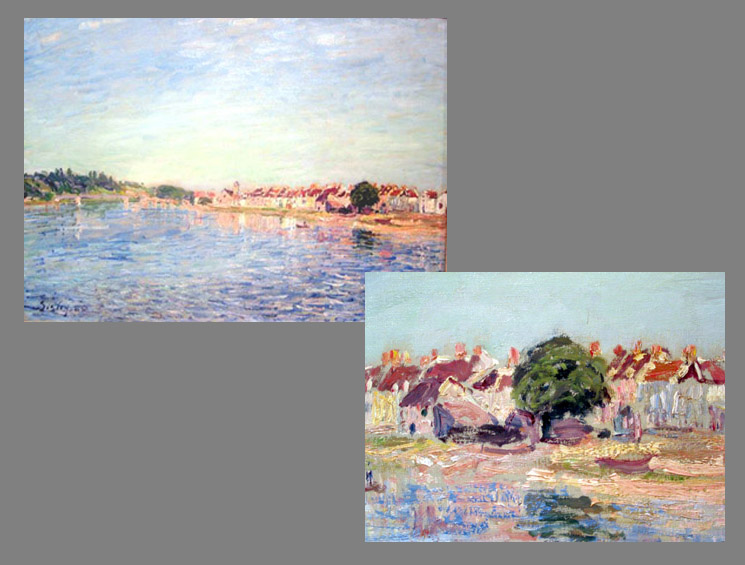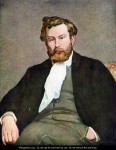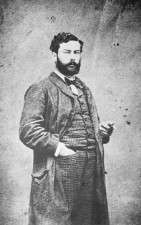
Alfred Sisley
English, 1839-1899 (active France)
Saint-Mammès, Banks of the Seine, 1885
oil on canvas
21 3/8 x 28 3/4 in.
SBMA, Bequest of Katharine Dexter McCormick in memory of her husband, Stanley McCormick
1968.20.6

Undated self-portrait, oil on canvas.
“Every picture shows a spot with which the artist has fallen in love. “ - Alfred Sisley
RESEARCH PAPER
Provenance: Bequest of Mrs. Katherine Dexter McCormick in memory of her husband, Stanley McCormick. Mr. McCormick had purchased SAINT MAMMES in 1900 from Paul Durand-Ruel Gallery. Durand-Ruel had purchased the painting himself from Sisley in 1891. Durand-Ruel's gallery was one of the few open to Impressionist artists, and from 1872 on he purchased over 400 paintings from Sisley during a period when it was virtually impossible to sell the paintings to the public, thus showing great faith in the artist, and at a time when Sisley was in desperate financial straits.
Exhibited: "The Impressionists and the Salon." California Collections. Los Angeles County Art Museum, April 16 - June 20, 1974.
Alfred Sisley is considered to be one of the finest representatives of the Impressionist Movement. Sadly enough, Sisley never lived to see this acceptance and acclaim of his work along side of his close friends, Renoir, Monet, Pissaro, and Bazille.
Sisley was born in France in 1839 to English parents. He lived most of his life in France, although he never obtained his French citizenship. Sisley was sent to London in 1857 to prepare himself for a business career, but during that time he was more interested in visiting museums and studying the artists Constable and Turner. Upon his return home he was able to persuade his family to allow him to study painting. In 1862 he became a pupil of Charles Gleyre where he met fellow students Monet, Renoir and Bazille. After several months of studying with Gleyre, Sisley soon realized that his teacher's ideas about painting were different than his own. The English landscape artists fired him with enthusiasm, and they stirred his feeling for light and pure outline and created a proper understanding of tone and value. Gleyre considered landscape a subject unworthy of a painter. Sisley had an ingrained love of solitude and the countryside, and was to have this as a dominant subject in his paintings in the ensuing years.
Sisley and his friends left Gleyre's studio in 1863 and it is sometimes said to be at that moment that Impressionism was born. The four men shared a love of painting, but not by rules outlined by any school, but under the inspiration of nature. They began to work in the open air for the first time, in the countryside particularly around Paris. Paint, now coming in tubes, portable and easy to carry about, allowed the artist to work directly from nature. There was a need to depict light rather than material compositional things…a new color palette was created (which roused the public to indignation)…Shadows were not gray and black but were colored with reflected light. Blacks, browns and earth-colors were excluded from their palettes in favor of greens, yellows, reds, slate blues, certain salmon pinks and lilacs. Luminous tones were attained by using a prismatic technique, apply…(line missing on copy)…colors of the houses, russets, yellows, salmons and whites, are reflected in the water as rather long, more thinly applied lines. At a close range you can see the pure colors juxtaposed on a contrasting initial layer of paint of the houses, giving them wonderful tones and luminous qualities. The treatment of the trees on the left side of the horizon is not quite as tactile feeling as the houses.
Even within the single body of water are subtle changes of color and brush strokes. Where the horizon comes forward on the right hand side of the painting, the treatment of the water is given short, choppy brush strokes, with minute touches of yellow, white and even salmon colored paint, again giving a luminous quality. On the left side of the painting where the horizon recedes, there is a calmer feeling in part of the water. A subtle change in color gives a more placid feeling and the brush strokes elongated, somewhat smoother. It is a painting one could never tire of looking at.
Ironically, Sisley was never able to realize more than three or four hundred francs for any of his paintings during his lifetime. From 1870 Sisley received no financial support from his parents, as the family business had been brought to ruin as a result of the war, and Sisley's father died shortly thereafter. Sisley was forced for the first time to depend upon his paintings to support himself, his wife and their two children. It was never an easy existence for him, as poverty was always a constant companion. Sisley had a sensitive and reserved nature. Although life was often difficult and ended so sadly for him, never did any of this heaviness or discouragement affect his painting.
Conclusion. As we look at the landscapes by Sisley, exemplified so beautifully and completely by the ST. MAMMES in our collection, one cannot help but be struck by the passionate, almost exclusive love of nature revealed in his work. Sisley was never tempted to paint the human face. He was essentially a landscape painter and he adhered throughout his lifetime to the Impressionist style and technique. At least one art historian felt Sisley was the only one to remain true to this style; he seemed isolated from the changes taking place around him. "It was because of this barrier of solitude that success did not come to Sisley at the same time as to other Impressionists, yet it was precisely his unfaltering dedication to the movement in its purest form that makes him the most total and absolute exponent of both the spirit and form of Impressionism."
Cogniat, Raymond, Sisley, Crown Publishers, Inc. New York, 1978. Translated from French by Alice Sachs. Page 91.
Prepared for the Santa Barbara Museum of Art Docent Council by Sherrill S. Henderson, April, 1981.
Website preparer, Nyna Mahan.

Undated photo of Sisley.
SBMA CURATORIAL LABELS
Though he was born and lived primarily in France, Sisley was the son of British parents and retained their nationality throughout his lifetime. While studying in the studio of Charles Gleyre, he met and befriended the aspiring artists Frédéric Bazille, Claude Monet, and Auguste Renoir. He exhibited with the Impressionists and like Pissarro, remained a dedicated landscape specialist throughout his career.
In this airy landscape, Sisley’s typically deft brushwork, applied in small dashes of vivid pigment, captures the windblown clouds and flowing waters of the Seine. Van Gogh considered him “the most tactful and sensitive of the Impressionists.” Sadly, Sisley was the only Impressionist who did not earn the financial rewards of critical recognition during his lifetime, and his art became highly sought-after only after his death in 1899.
- Through Vincent's Eyes, 2022
